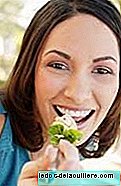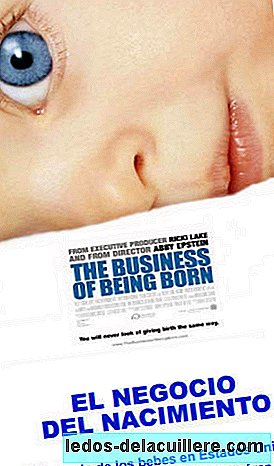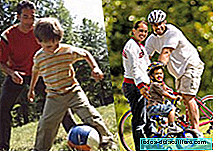
One of the issues that most worries parents is that of infant feeding. We always think that he eats a lot, that he does not eat enough, that we do not give him the most appropriate ... Here are some frequent mistakes in infant feeding that we remember, to ensure that our children eat healthy.
Introduce cow's milk before 12 months
Cow's milk should not be introduced before 12 months of the baby. WHO recommends breast milk for children for at least two years.
Cow's milk is not suitable for such early ages for various reasons, and it is after 12 months when it can be taken, replacing artificial milk in the case of non-breastfed babies.
Take more than three dairy products or rations a day
In many western countries, milk is considered a fundamental and essential food during childhood because it is considered to be almost the only source of calcium and it is not uncommon to find children taking excessive amounts of milk or its derivatives (yogurts, custard, petit suisse , cheeses ...). This can lead to deviations from the children's diet and other problems, for example:
- If they drink a lot of milk or milk products, they may not have an appetite for other foods and the diet is monotonous and poor in some nutrients.
- Milk is rich in calcium but contains very little iron. Both minerals are necessary. And we must bear in mind that iron is not absorbed well in the presence of calcium.
- Cow's milk and its derivatives provide animal fats, rich in saturated fatty acids.
- Abusing dairy can lead to constipation and abdominal pain.
- Some people do not digest milk. From 2-5 years they lose the ability to digest it. This occurs more frequently in some races (Asian, black, American) than in others (Caucasian). In those cases, drinking milk is accompanied by abdominal pain, gas, acid feces and irritation of the anus. To those who happen, they may have nausea when they drink milk or reject it without further explanation. They usually tolerate fermented dairy products (cheese, yogurt or kefir).
Always give dairy dessert
Related to the previous point, we have the fact that many families always offer dairy products for dessert to their sons and daughters. In most cases they do it because they believe that the feeding is more complete. Too for comfort, since children often prefer yogurts, custards and custard to fruit, they take them faster and do not have to help or teach them how to peel the fruit.
However, as we have just seen, most of the children drink a lot of dairy throughout the day and very little fruit. The fruit contains many vitamins. Specifically, vitamin C contributes to the assimilation of iron from other foods that have been taken at lunch, so that some fruit or half a glass of freshly squeezed natural juice better complement the midday meal.
It is convenient that they get used from the first year to take the fruit into small pieces and set an example by always having varied fruits of the season at hand.
Fruit is a good snack at all ages. Presenting it on the table already peeled and chopped makes it easier for the little ones to eat it. The dairy dessert can be taken once a day (better if it's homemade), or we can start combining it with pieces of fruit.

Take packaged juices
Commercial juices have become fashionable. Some people consider that it is a suitable food for all ages, and that they perfectly replace natural fruit, which is not correct. But juices do not replace fruit.
The fruit contains natural sugars, and also fiber, minerals and vitamins. In the juice only the sugars remain. The fiber disappears and part of the vitamins too. In some cases they are added after artificially.
They actually contain only between 5 and 8% of fruit. The rest is water. In proportion, they provide very high amounts of energy, coming from carbohydrates (sugars) and yet they lack other essential nutrients.
Its excessive consumption (more than 120 ml. Per day) seems to be related to some health problems such as:
- Abdominal pain, meteorism and chronic diarrhea due to the high concentration of sorbitol (a natural fruit sugar).
- Dental caries, by the action of sugars in contact with the teeth.
- Inapetence, because they facilitate the feeling of satiety and can lead to nutritional imbalances (not taking other more important foods from the point of view of nutrition) and even malnutrition.
- Obesity, because they provide extra calories.
- Something similar happens with sugary sodas. A 300 ml can of soda equals almost 12 teaspoons of sugar.
It is important to know that sweet drinks do not relieve thirst, but encourage you to drink more. That is to say that they do not satisfy. To quench thirst, water is the best drink. In addition, juices prevent chewing and tasting different varieties. So it is preferable that they are not part of the children's diet more than occasionally.
Snacks or soft lunches based on bread and pastries
Foods of somewhat hard consistency, which make teeth and jaws work, favor the development of the muscles of the face and chewing, while strengthening teeth and gums.
On the contrary, foods that are too soft, not only avoid that small but beneficial effort, but often, being composed of sugars, adhere to the teeth and contribute to the appearance of decay. further bakery products and bread rolls usually have added fat, who does not have the bread of the day.
It is more advisable that boys and girls have lunch and snack foods of more consistency: sandwiches of normal bread and fruit in pieces.
Ask the little ones what they want to take
Now that my oldest daughter knows the chocolate and muffin delights, I would probably take them at every meal. The responsibility of choosing the menu, buying food and designing a complete diet It is not for children, but for the people who care for them.
Children often choose foods that are too sweet or too salty, if they are offered. This can happen much more often in families that do not have too many notions of nutrition.
Mothers and fathers should have the necessary knowledge to make a varied and balanced diet. And, of course, these bases should be taken into account in the development of school menus.
It is appropriate to offer children the possibility of choosing between two or more foods that adults have already planned, but within healthy options. And it is that even less attractive a priori foods can be offered and / or cooked in a suggestive way.
Once you have established healthy eating habits, the possibilities of choice increase, and there may also be “exceptions” (a birthday, a meal in a restaurant…) in which, for example, a chocolate dessert or a hamburger is welcome.
In short, these are some of the most frequent mistakes in infant feeding, which we hope we have clarified and help us develop healthier menus for our children.












